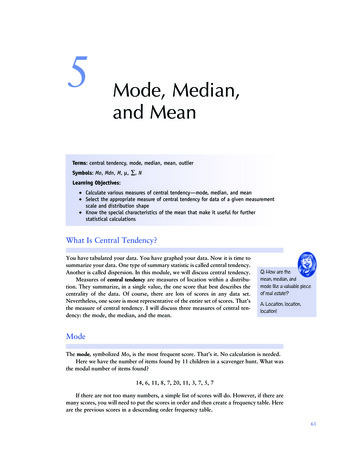
Transcription
Advances in Economics, Business and Management Research, volume 29International Conference on Innovations in Economic Management and Social Science (IEMSS 2017)Research on the Mode of Cultivating Football Reserve TalentsBased on UniversityWeiping XiePingxiang University, Pingxiang, Jiangxi, 337055, ChinaKeywords: university pivot; football reserve talents; training modelAbstract: The purpose of this research is to establish a scientific and reasonabletraining model of football reserve talents based on university which is as the mainbody. The university as the hub and the professional club as the basis explore thefeasibility of incorporating the training of competitive football reserve talents into theschool education track. This model for the development of China's football industry tobring positive significance is expected.1. IntroductionModern football is one of the earliest sports programs which are carried out bycolleges and universities in China [1-3]. Cultivating football talents in Chineseuniversities has a long history. According to historical records, as early as 1901,China's Shanghai St. John's University and Nanyang University has set up a footballteam [4]. The two schools played a match once a year since 1902. From 1923 to 1937,located in the mainland of West China University, Sichuan University have also setup a football team. Shanghai Jiaotong University football team also visited NewZealand, Japan and other countries to compete [5, 6]. The establishment of theseschool teams and activities for the development of old Chinese football played asignificant role in promoting football career [7].Many scholars have studied and discussed the mode of cultivating football reservetalents in China [8]. It is believed that relying on the main line of school,strengthening the cooperation between sports and education departments to build up atrain model of football athletes through "university - middle school - primary school".The Football association changed its functions, and from the previous "do" to"management" change the focus of the work more biased in favor of the developmentof youth football. The establishment of soccer players in harmony with the physicaland mental development of scientific football reserve personnel training approach isneeded.2.Research purposesFootball reserve talents are the basis of the development of a national football. Theworld's football power are strategic vision, and take different ways to cultivate reservetalents. It is an important guarantee to expand the football population, improve thelevel of football, and promote the sustainable, stable and healthy development ofCopyright 2017, the Authors. Published by Atlantis Press.This is an open access article under the CC BY-NC license 19
Advances in Economics, Business and Management Research, volume 29soccer. Since 1994, China's professional football league has brought new vitality butat the same time it should be clear to see that the current level of China's football doesnot achieve "quality" breakthrough. This study attempts to build a university as a hubfor the cultivation of football talent model analysis, and to achieve the followingresearch objectives:(1) Understand the status of the current football reserve talents training mode andthe development of football in primary and middle schools, and explore the causes ofthe existing problems.(2) Analyze the existing problems in the training mode of the"reserve-sports-education" model for Chinese soccer reserve talents, and summarizethe characteristics, advantages and disadvantages of this training mode.(3) Try to explore a scientific and reasonable way of football reserve personneltraining, and gradually improve the "combination of sports and education" model forour football reserve personnel training to provide a new path.3.Research methods3.1 The design of the questionnaireAccording to the content and purpose of this study, and following the basicrequirements of sociology on the design of the questionnaire, the author designed anew method for the design of the questionnaire, and made a thorough study on thesubject, " Expert questionnaire "," coaches' questionnaire "and" athlete questionnaire".3.2 The issuance and recovery of the questionnaireTable 1. Questionnaire issuance and recoveryExpert questionnaireCoach questionnaireAthlete questionnaireTotalNumber ofdistributedNumber %100%93.6%94.7%The questionnaires were sent by email and sent to friends. The questionnaires weredistributed to 15 experts, 14 coaches, and 140 questionnaires for athletes. 167 wererecovered, and 160 valid questionnaires and the total recovery rate was 98.8%. Theeffective recovery rate is 94.7% (see in Table 1).4.Research results and analysis4.1 Introduction of the current football reserve personnel training modeChina’s traditional three - tier network training management system is: grass roots schools - amateur sports schools - provincial professional team of personneltraining mode. This traditional system has long been used nationwide, and it ischaracterized by: personnel training in the form of linear training and selection systemwhich is funded by the state. After coaches preferred, pure planning organization isused. In 1994, the former State Sports Commission of football as a breakthrough in120
Advances in Economics, Business and Management Research, volume 29sports, football as a pilot system reform, and the establishment of professional footballclub in China is established. The implementation of professional, football began tomarket and industrialization road. Football reserve personnel training also begins to amulti-polarization. This is manifested in: the proportion of government investmentdecreases from the past plan to train the system to market-oriented training system; inthe youth football talent training approach, the football club echelon, private footballschools and amateur clubs come into being, and enrich the youth football talenttraining channels. At present, the main ways of cultivating young talents in China areprofessional club echelon, football school, amateur club, amateur sports school andtraditional project middle school.Figure 1. The main ways of cultivating our football reserve personnel4.2 A brief introduction to the present training mode of high - level gootballteams in colleges and universities4.2.1 The level of the athletesIn the surveyed schools, more than one of the football players is only 14 people toinvestigate the total number 10.7%, of which there is no fitness level football player.In the present study, the reasons for the lack of high-level football players are asfollows: first, in recent years, colleges and universities pay attention to the formationof high-level football teams, and competition for talent is increasing; secondly, theemployment pressure of college graduates is increasing, and the level of athletes cannot find a satisfactory job after graduation, so they tend to rely on the existingcapacity as soon as possible to find their own social position.The results of a detailedsurvey of 131 student athletes from seven universities (Jiangsu University, NanjingUniversity of Technology, Henan University and Shanghai Institute of PhysicalEducation) are shown in Table 6.121
Advances in Economics, Business and Management Research, volume 29Table 2. Athlete level situationMaster classLevel oneLevel twoTotalNumber of peoplePercentage0141171310%10.7%89.3%100%4.2.2 Construct the reserve talent model of football in universitiesTo build a "pyramid" type of football reserve personnel training mode, which issolid in foundation, smooth in transportation channel, reasonable in structure andclosely connected with each level, is a strategic measure to keep the sustainabledevelopment of Chinese soccer competitive level. In this study, based on the existingfootball reserve personnel training system and the successful experience of developedcountries, the paper puts forward a new type of football reserve talent training modebased on the school system as the main body, the university as the hub and theprofessional football club as the basis. Cultivate high-quality cultural, athletic leveland the overall quality of the high-quality football reserve personnel. Promote thecause of China's football health, vigorous development as the ultimate goal.Figure 2. Cultivating soccer reserve talents model path with university as the hub4.2.3 The new model of innovationThe current system of football reserve personnel training model is lack ofsystematic management and integrity of the structure, and it can not be effective toensure the number and quality of the game. Competition is an effective way to test thetraining effect, and it is also a platform for athletes to display and improve their skills.It can effectively promote the progress of athletes and the running of sports teams.Therefore, the establishment and development of competition system must beattached importance in the training of football reserve talents. The new model which122
Advances in Economics, Business and Management Research, volume 29is established from the primary school football exchange training camps to the collegestudents football league competition system, fully guarantee the athletes and sportsteams to get exercise training and mutual learning exchange opportunities.5.SummaryThe new model of football reserve talents training based on the university isfeasible, which can promote the comprehensive development of athletes, expand thetalent base, provide the smooth channel of talent transmission, and accord with thedevelopment trend of football and modern society to the talented person of thedemand. China's football reserve personnel training system development andimprovement have a positive significance. The development of the new modelrequires the support of the government and the enthusiasm of all sectors of society toparticipate. In the course of deepening the system reform of high-level sports teams incolleges and universities, it is inseparable from the support of the government, thecooperation of social organizations, enterprises and institutions, to explore the newmode of cultivating football reserve talents with schools as the main body.References[1]. Wang R. Training and Reform Scheme of Football Talents in China[M]//Proceedings of the 2nd International Conference on Green Communications andNetworks 2012 (GCN 2012): Volume 4. Springer Berlin Heidelberg,2013:309-317.[2]. Lang J, Wang C, Wang J, et al. Building the Mode of Training Football Talents inChinese Schools[J]. Journal of Shenyang Sport University, 2014.[3]. Kourunen. Research on Physical Training of Sports Reserve Talents of Groupball Games in Combination with Gymnastics[J]. Journal of Capital University ofPhysical Education & Sports, 2016.[4]. Brady C, Bolchover D, Sturgess B. Managing in the talent economy: the footballmodel for business[J]. IEEE Engineering Management Review, 2012,40(1):58-72.[5]. Dong H Q. Youth football training philosophy and training of football reservetalents[J]. Journal of Jiamusi Education Institute, 2012.[6]. Ren C. Talents Training Models of the World's Major Soccer Powers andEnlightenment[J]. Journal of Shenyang Sport University, 2011.[7]. Shi L I, Xue-Jun. On Reserve Personnel Training System of Women FootballAthletics in China[J]. Journal of Huizhou University, 2012.[8]. Huffman L T, Cooper C G. I'm taking my talents to. an examination of hometownsocio-economic status on the college-choice factors of football student-athletes ata southeastern university.[J]. Journal of Issues in Intercollegiate Athletics,2012(5286):403.123
cause of China's football health, vigorous development as the ultimate goal. Figure 2. Cultivating soccer reserve talents model path with university as the hub 4.2.3 The new model of innovation The current system of football reserve personnel training model is lack of systematic management and integrity of the structure, and it can not be .











